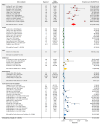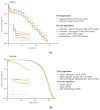Systematic Literature Review Shows Gaps in Data on Global Prevalence and Birth Prevalence of Sickle Cell Disease and Sickle Cell Trait: Call for Action to Scale Up and Harmonize Data Collection
- PMID: 37685604
- PMCID: PMC10488271
- DOI: 10.3390/jcm12175538
Systematic Literature Review Shows Gaps in Data on Global Prevalence and Birth Prevalence of Sickle Cell Disease and Sickle Cell Trait: Call for Action to Scale Up and Harmonize Data Collection
Erratum in
-
Correction: Colombatti et al. Systematic Literature Review Shows Gaps in Data on Global Prevalence and Birth Prevalence of Sickle Cell Disease and Sickle Cell Trait: Call for Action to Scale Up and Harmonize Data Collection. J. Clin. Med. 2023, 12, 5538.J Clin Med. 2024 May 14;13(10):2893. doi: 10.3390/jcm13102893. J Clin Med. 2024. PMID: 38792559 Free PMC article.
Abstract
Sickle cell disease (SCD) is an inherited monogenic disorder with high prevalence throughout sub-Saharan Africa, the Mediterranean basin, the Middle East, and India. Sources of SCD epidemiology remain scarce and fragmented. A systematic literature review (SLR) to identify peer-reviewed studies on SCD epidemiology was performed, with a search of bibliographic databases and key conference proceedings from 1 January 2010 to 25 March 2022 (congress abstracts after 2018). The SLR followed PRISMA (Preferred Reporting Items for Systematic Reviews and Meta-Analyses) guidelines. Meta-analyses, using a binomial normal random-effects model, were performed to estimate global and regional prevalence and birth prevalence. Of 1770 journal articles and 468 abstracts screened, 115 publications met the inclusion criteria. Prevalence was highest in Africa (~800/100,000), followed by the Middle East (~200/100,000) and India (~100/100,000), in contrast to ~30/100,000 in Europe. Birth prevalence was highest in Africa (~1000/100,000) and lowest in North America (~50/100,000) and Europe (~30/100,000). This SLR confirmed that sub-Saharan and North-East Africa, India, the Middle East, and the Caribbean islands are global SCD hotspots. Publications including mortality data were sparse, and no conclusions could be drawn about mortality. The identified data were limited due to gaps in the published literature for large parts of the world population; the inconsistent reporting of SCD genotypes, diagnostic criteria, and settings; and a sparsity of peer-reviewed publications from countries with assumed high prevalence. This SLR demonstrated a lack of systematic knowledge and a need to provide uniform data collection on SCD prevalence and mortality.
Keywords: epidemiology; sickle beta-thalassemia; sickle cell anemia; sickle cell disease; sickle cell trait.
Conflict of interest statement
R.C. has received consultancy fees from Global Blood Therapeutics; advisory board honoraria from AddMedica, Novartis, Forma Therapeutics, Global Blood Therapeutics, Novo Nordisk A/S, and Vertex; and research funding from Global Blood Therapeutics. I.H., M.M. and C.B. are employees of Novo Nordisk A/S.
Figures









References
-
- Ranque B., Kitenge R., Ndiaye D.D., Ba M.D., Adjoumani L., Traore H., Coulibaly C., Guindo A., Boidy K., Mbuyi D., et al. Estimating the risk of child mortality attributable to sickle cell anaemia in sub-Saharan Africa: A retrospective, multicentre, case-control study. Lancet Haematol. 2022;9:e208–e216. doi: 10.1016/S2352-3026(22)00004-7. - DOI - PubMed
-
- Lubeck D., Agodoa I., Bhakta N., Danese M., Pappu K., Howard R., Gleeson M., Halperin M., Lanzkron S. Estimated life expectancy and income of patients with sickle cell disease compared with those without sickle cell disease. JAMA Netw. Open. 2019;2:e1915374. doi: 10.1001/jamanetworkopen.2019.15374. - DOI - PMC - PubMed
Publication types
Grants and funding
LinkOut - more resources
Full Text Sources
Medical
Miscellaneous

